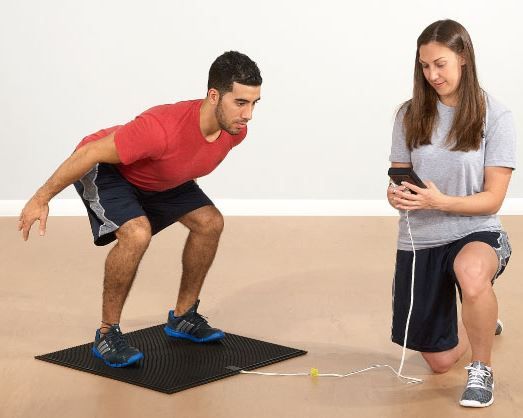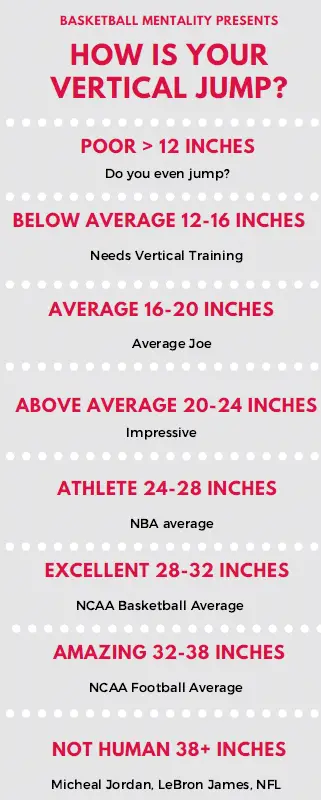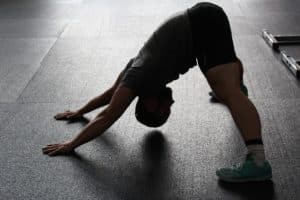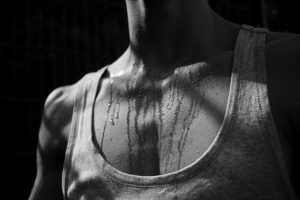Last Updated on: 29th April 2024, 10:23 pm

The vertical jump test is an important test when it comes to athletes, especially in basketball and football.
If you watch the NBA draft combine or the NFL combine, you will see that a lot of weight is put on the vertical jump test to judge a player’s potential and explosiveness.
If you want the most accurate results when measuring the vertical jump, a piece of equipment called a Vertec jump tester, where the players try to touch as many flags as possible toward the top of the pole. The highest flag touched will be your vertical jump score.
This vertical jump test, also known as the Sargent jump test, tests the power of your lower body. The goal is to see how high a person jumps.
This is done by measuring the distances between the standing reach height and the jump height score.
A player’s vertical is a test for pure athleticism, and when coaches and scouts look at where a player’s vertical ranks, it can tell them a lot about what they think the player can bring to their team.
This is why athletes ask How To Measure Vertical Jump And Standing Reach?
How To Measure Vertical Jump At Home
There are multiple ways to test your vertical from home…
We are not saying one way is better; we will let you decide for yourself.
Below we will go through the different ways you can measure your vertical while at home and the pros and cons of each…
If you want to have information or the motivation for How Tall Do You Need To Be To Dunk, then read the article on this link.
So you can decide what the best method for you is…
1. Chalk and Wall

This is an old-school way, and the best part is that it is super cheap, and everyone can do this from home. You only need some (1)chalk and a (2)wall.
Here are the steps for you to complete…
- Chalk you fingertips
- Stand next to a wall (standing with your side facing the wall, Do-Not face the wall)
- Now, with your feet planted flat on the ground, reach as high as you can with your hand closest to the wall, and with your fingertips, mark the wall. This is your standing reach
- Now, squat jump as high as you can in the same position, reach as high as you can with the same hand you marked the wall with earlier, and touch the wall with your fingertips at your highest point.
- The last thing is calculating the difference between steps 4 and step 3. This is your vertical.
For example, if your standing reach is 96 inches (8 feet) and when you jump, it measures 120” inches (10 feet). Your vertical will be 120”(4)-96”(3), which equals a 24“(5) inch vertical.
Repeat this a couple of times and take an average of your results to ensure you get a more accurate result.
Tip: You can do this with tape instead of chalk; wrap the tape to make it double-sided and stick it to your fingertips. Then follow steps 2-5.
Pros:
- Cheap
- Everyone can do it
- You can use tape instead of chalk
Cons:
- It can be messy with the chalk
- It may not provide accurate results
2. Vertec (Professional Vertical Jump Test)
If you have ever watched the NBA Draft Combined, there is a good chance that you have seen one of these.
Professional athletes and colleges use Vertec because it gives the most accurate results of a player’s vertical jump.
A Vertec is a giant pole that has horizontal flags that are fixated to rotate around the central pole when touched.
Using a Vertec is simple; first, you need to assess your standing reach…
So, standing flat-footed, reach as high as possible and push aside as many flags as possible. The highest flag pushed aside is your standing reach.
Then, you jump using a max vertical or a standing vertical.
Finally, add up how many additional flags you pushed aside, which is your vertical jump height.
For more information on how to use a Vertec, watch the video above.
Pros:
- Fast and very accurate results
Cons:
- Athletes can try to inflate their results by not reaching as high as they can during the standing reach to make their vertical seem higher than what it is.
- A quality Vertec device will cost around $799, which does not make it feasible for a typical player to measure their vertical at home. Therefore, it is used mainly by the NBA, NFL, and colleges.
3. Vert Wearable Jump Monitor

The most popular wearable technology to measure your vertical jump is the Vert Wearable Jump Monitor
This device measures your vertical jumps and logs the data on your smartphone.
The vert wearable jump monitor has various features that give the athlete abundant information…
These features include…
- Jump feature
- Jump count, % of max, best jump, average height
- Energy feature
- Landing impact, kinetic energy, dynamic movements
- Stress feature
- Stress %, efficiency, prevention of injuries
- Run feature
- Run impact, total energy, speed graph, monitor stress, IOS GPS integration
- Jump rope feature
- Jumps, jump per minute, endurance
- Drill feature
- Vertical beep test, standing vertical test, max vertical test
The VERT wearable technology comes with a belt, so you can wear it anytime at home, during a game, at practice, or the local park.
Testing different jumps, like standing vertical and max vertical, and how you jump with a basketball in your hand makes this device a great tool.
The accuracy of this device is accurate; at worst, it is about 0.5” inches off your typical vertical.
Some players have been known to wear it during games to see how many times they jumped and how high their vertical was in-game.
This system is used by over 350 colleges, and professional & Olympic teams worldwide, so you can’t go wrong.
Pros:
- Accurate results
- Small, portable & hands-free
- Relatively cheap
- Fast results
Cons:
- The App could be improved
- The subscription fee of $6.99 a month but worth it for more serious athletes
4. Force Plate

The Force Plate measures the force applied to the plate during takeoff and landing to determine your vertical.
Used mainly in a laboratory setting because of the accuracy, but these will run you thousands of dollars…
For this reason, it is not recommended for the average person.
The Force plate does give precise data on the athlete’s vertical jump height, the energy produced, and other variables.
If you like this idea, there is a cheaper system, and it is called the Just Jump System.
This system is a jump mat that you jump on and works by measuring your hang time…
It does this by measuring the data when it can not read a ground reaction force; this is easily done because gravity is a constant on Earth.
This allows the Just Jump System to give an easy and accurate result.
Pros:
- Accurate
- Compact
- Simple to use
Cons:
- Expensive
- The increased hang time could skew the results if athletes jump and do not have to extend their knees.
How Does The NBA Measure The Vertical Leap?
Check out this video:
The NBA uses two vertical test forms…
- Standing or No Step Vertical: When a player jumps with no extra steps, the player must take off from a flat-footed standstill position. This can simulate players going up for rebounds.
D.J Stephens completed the highest standing vertical at the NBA Draft Combined at 40 inches
- Max Vertical Jump: This vertical test allows players to take up to 3 steps to explode upward and see how high they can jump. This form results in a much higher vertical when compared to the standing vertical test. This simulates when a player drives to the rim for a dunk.
D.J Stephens also achieved the highest Max vertical at the NBA Draft Combined at 46 inches.
The technique is vital during the standing and max vertical tests.
Why You Should Test Your Vertical?
Testing your vertical jump is essential for tracking your progress in your journey to increase your vertical and maximize your explosiveness.
Testing your vertical is a good indication of your athletic ability and can lead you to the right mindset of where you want to be when it comes to your vertical jump height.
Testing your vertical jump at home can mentality give you an edge to accomplish your vertical goals no matter if your goal is to get your first dunk or to achieve a 30″+ vertical.
A quick tip: If you have a vertical test coming up for whatever reason, you need to test your vertical beforehand for two reasons…
The first reason is you need to familiarize yourself with the vertical test…
The second reason is you will be able to achieve quick improvements by testing your performance regularly; make sure you are focusing on the element of the technique of the vertical jump.
Difference Between NFL and NBA When Measuring Vertical Jump
The NFL Draft Combined also measures players’ vertical jumps so scouts and coaches can better understand the player’s athletic ability.
The NFL uses the same measuring device as the NBA, but the NFL only calculates the Standing Vertical jump. NFL players, on average, have higher verticals than NBA players.
The highest standing vertical record holder in the NFL Draft Combined is held by Gerald Sensabaugh, who achieved a 46-inch standing vertically.
Now let’s dive into how you can test your vertical at home.
How to Measure Standing Reach
Standing reach measures how high someone can reach with their hands while standing flat-footed. It is an important measurement for basketball players because it determines how easily they can get off shots against a defender and how well they can play defense. Here are some ways to measure standing reach:
- Against a wall: Stand side-on to a wall and reach up with the hand closest to the wall. Keeping the feet flat on the ground, mark the point of the fingertips and measure the distance from the ground.
- With a friend: Have a friend put a mark at the top of your finger while you reach up with your hand close to the wall. If you don’t have a friend, you can do it yourself by keeping your hand close to the wall, going on your tip-toes, feeling your fingertip, and putting a little mark. Then, measure the distance from the ground.
- Using a Vertec Vertical or Jump & Reach test: Stand below the apparatus with feet flat on the floor and reach up as high as possible. The height from the ground to the highest point reached is the standing reach.
Once you have measured your standing reach, you can calculate your vertical jump height by subtracting your standing reach from your maximum jumping reach
Where Do You Stand With Your Vertical?
Knowing where you stand compared to others can motivate you to increase your vertical even more…
It is good to get a baseline with one of the methods above, and then when you train, test your vertical again.
Make sure you keep records because showing that you improved is motivation.
If you are curious about where your vertical stands, check out the infographic below that, we created…

Tips Before Starting
1. Warm-Up Is Key

Testing yourself before any warm can lead to injury and lackluster results.
Warming up will produce better results and reduce your risk of injury.
To warm up, you should do dynamic leg stretching and a few warm-up jumps; this will get the blood flowing and to your muscle loss.
2. Technique
It is proven that the correct jumping technique can improve your vertical by 2-3 inches.
When conducting a vertical test, the most important thing is to swing both arms so you can use that extra momentum to explode upwards and achieve maximum jump height.
3. Fatigue

Having fatigue can hinder your vertical jump greatly.
Fatigue can happen by over-training…
When testing your vertical, make sure your muscles are well-rested…
Your fast-twitch muscle fibers are responsible for the explosion that gets you in the air…
These types of muscles are more sensitive to fatigue than other muscle types.
Fatigue can come in the form of sore muscles or exhaustion and sluggishness.
The best way to prevent this is to ensure adequate rest and sleep.
You Can Train Your Vertical Jump
If you feel like your vertical can be higher or you are unhappy where it is at…
Don’t worry; it can be trained.
For athletes who play sports like basketball and football, their vertical is being trained ultimately by playing the sport.
However, athletes look towards leading vertical training programs to increase their vertical fast through specialized training.
How Can Your Vertical Be Trained
One thing in sports that every player has the power to do is increase their vertical…
Although this is not an easy thing to do.
There are multiple ways you can train your vertical; some of these ways are by looking up videos on YouTube or joining a vertical training program.
Joining a program is the easiest and fastest way to get your vertical where you want it to be because you are learning from a trainer who has been in the game for a while and has a proven system…
Watching videos on YouTube can be hit-or-miss if you get reputable information.
If watching YouTube, ensure you are not taking any unnecessary risk by using dangerous techniques and methods that could cause season-ending injuries.
But if you are looking into a program, check out the top 2 rated vertical training programs below…
Vert Shock: Top Choice

Vert Shock is an 8-week vertical training program that promises to increase your vertical by at least 9 inches.
You can check out my personal experience with the program if you would like…
Just to let you know, I have no problem throwing it down now.
Created by Adam Folker, Vert Shock is the best vertical jump program for most players looking to increase their vertical.
Adam’s program can be done from home because Vert Shock focuses on plyometrics, so you will not need a weight room.
Athletes from multiple levels worldwide have seen eye-popping results with this system because Adam spent years perfecting it.
If you want to learn more, you can check out our full review of the vertical training program here.
Jump Manual Second Choice
Created by Jacob Hiller, Jump Manual is for athletes that want weight room-focused vertical training…
Remember, when training with weights, there is an increased risk of injury if done incorrectly.
For this reason, the Jump Manual is not recommended for beginners to do vertical training or when it comes to lifting weights.
Hiller has over ten years of experience and has trained athletes of all levels, from high school to professionals in over 65 countries.
Jump Manual was featured on ESPN, so you know that it has proven results.
I did a detailed review of the Jump Manual that you can check out here.
The Jump Manual vertical training is a 12-week demanding program but well worth it if you give 100%.
You will achieve heights in your vertical jump that you did not think were possible.

